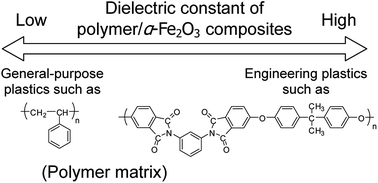Highly improved dielectric properties of polymer/α-Fe2O3 composites at elevated temperatures
Abstract
α-Fe2O3 particles were incorporated into ten kinds of polymer matrices, and the dielectric properties of the resultant polymer/α-Fe2O3 composites were investigated between 40 °C and 160 °C. We found that the dielectric properties strongly depended not only on the temperatures but also on the kind of polymer matrices. For engineering plastics such as polyetherimide (PEI), the dielectric constant ε′r was highly enhanced at around 1 kHz by incorporation of the α-Fe2O3 particles owing to Maxwell–Wagner polarization of free electrons in the α-Fe2O3 particles. This is probably because the π electrons in the aromatic structures of the engineering plastics strongly interact with the electrons in the α-Fe2O3 particles. Furthermore, the dielectric loss factor ε′′r for the engineering plastics became small at elevated temperatures because the conductivity of the α-Fe2O3 particle was enhanced and therefore the relaxation frequency of Maxwell–Wagner polarization was shifted to higher frequency. PEI/α-Fe2O3 composites exhibited highly improved dielectric properties at around 1 kHz, the high ε′r and very low ε′′r at the elevated temperatures above 120 °C. It was demonstrated that the PEI/α-Fe2O3 composite was comparable to the PEI/BaTiO3 composite in dielectric performance at 160 °C. Because the cost of α-Fe2O3 is much lower than that of BaTiO3, the PEI/α-Fe2O3 composite might be promising as a low-cost dielectric material for high-temperature applications.


 Please wait while we load your content...
Please wait while we load your content...